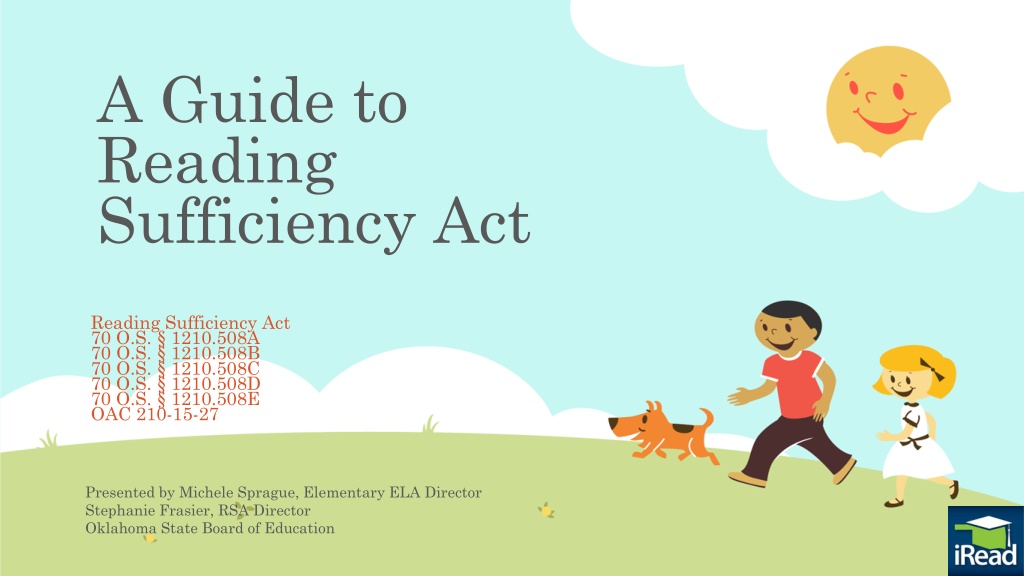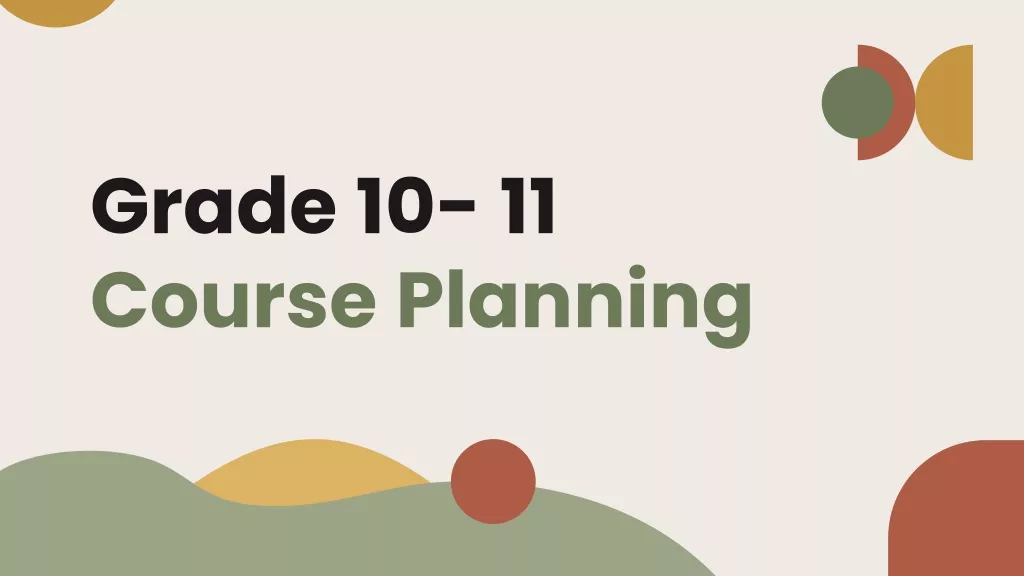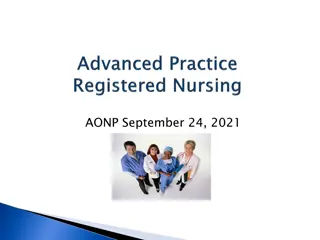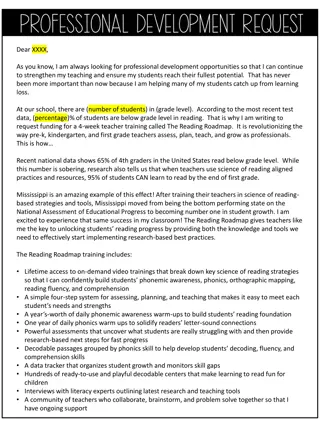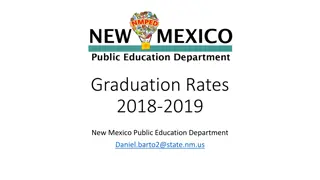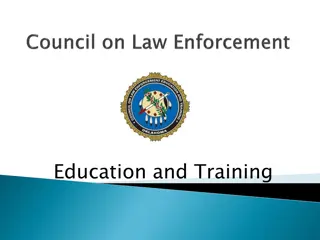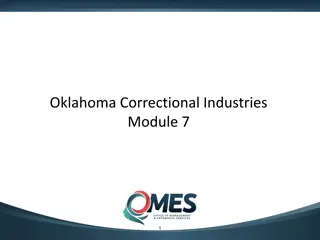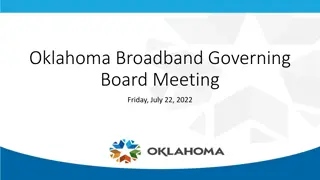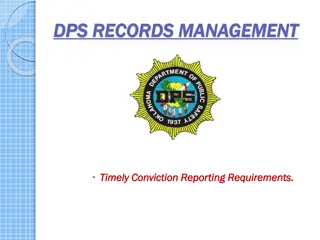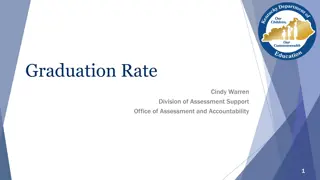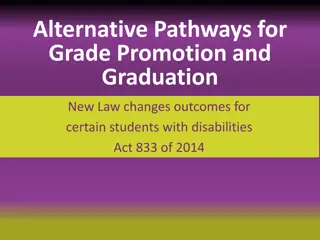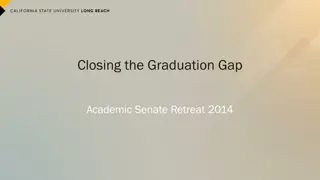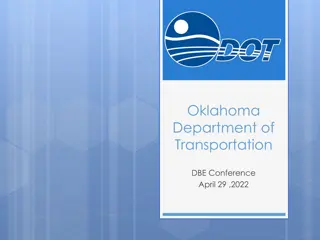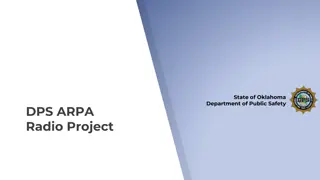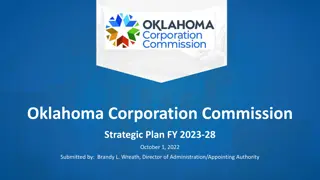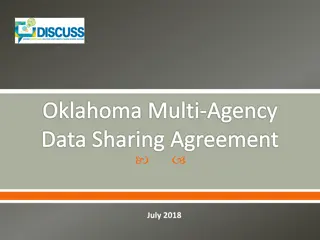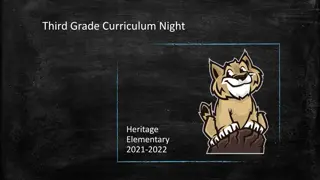Understanding Oklahoma's Third Grade Graduation Law and Reading Sufficiency Act
Oklahoma's Third Grade Graduation Law places importance on students reading at a third-grade level before entering the fourth grade. The law outlines conditions for students to qualify for automatic promotion, including demonstrating proficiency through assessments and exemptions. Benchmark assessments are conducted throughout the year, with approved assessments by the State Board of Education. The law aims to ensure students achieve reading proficiency and provides exemptions for those meeting the necessary criteria.
Download Presentation

Please find below an Image/Link to download the presentation.
The content on the website is provided AS IS for your information and personal use only. It may not be sold, licensed, or shared on other websites without obtaining consent from the author. Download presentation by click this link. If you encounter any issues during the download, it is possible that the publisher has removed the file from their server.
E N D
Presentation Transcript
A Guide to Reading Sufficiency Act Reading Sufficiency Act 70 O.S. 1210.508A 70 O.S. 1210.508B 70 O.S. 1210.508C 70 O.S. 1210.508D 70 O.S. 1210.508E OAC 210-15-27 Presented by Michele Sprague, Elementary ELA Director Stephanie Frasier, RSA Director Oklahoma State Board of Education
Third Grade Graduation Law The law outlines the adults responsibilities in a student s academic career, leading up to and including third grade, who endorse the student reading on a third grade level before entering fourth grade.
Third Grade Graduation Law Oklahoma law states a student may qualify for automatic promotion to the fourth grade if one of these four conditions are met:
Third Grade Graduation Law Conditions: Demonstration of Third Grade Level Proficiency on a Screening/Benchmark Assessment Qualification through use of a student portfolio Scoring Limited Knowledge on the OCCT Application of the other Good-Cause Exemptions http://ok.gov/sde/parent-resources
Benchmark Assessment Districts are still required to conduct beginning, middle and end of the year screening/benchmark assessments. Amendments to the law exempt students who demonstrate proficiency in reading at a third grade level from the retention requirements of RSA. Determination not made on cut scores, but on requisite level of performance. Written notification to parents required. http://ok.gov/sde/parent-resources
Oklahoma State Board of Education Thirteen RSA Formative Approved Assessments aimsweb Children s Progress Academic Assessment Dibels NEXT DRA+ easyCBM GRADE iREADY Literacy First mClass Dibels Next Measured Academic Progress (MPG) Measures of Academic Progress (MAP) for Primary Grades STAR Early Learning Enterprise (Star Early Literacy and Star Reading) Woodcock Reading Mastery Tests, Third Edition (WRMT- III), NCS by Renaissance Learning, Inc.
Oklahoma State Board of Education Thirteen RSA Formative Approved Assessments Districts Must Be Aware that Each of the 13 RSA Formative Approved Assessments Have Allowable Accommodations These Accommodations Must Be Provided to Students Based on Their IEP.
Portfolio School district must begin compiling a student portfolio for every student who demonstrates a significant reading deficiency. Demonstration of deficiency is based on screening/benchmark assessment (Not scoring at third grade level) District must immediately begin compiling Portfolio Portfolio must meet requirements of OAC 210: 15-27-2 Detailed parental notification required. See subsection (1) if statute Student shall continue to receive intensive remediation http://ok.gov/sde/parent-resources
Limited Knowledge Law requires written notification to parents/legal guardians that the student is not reading on grade level and the option for retention if they so desire. LK students shall be entitled to receive intensive remediation Student Reading proficiency team is assembled to create IRP Continued monitoring to ensure requirements of IRP are met http://ok.gov/sde/parent-resources
Third Grade Graduation Law If a third grade student does not meet one of these requirements for automatic promotion then the student will either receive probationary promotion or be retained in the third grade.
Probationary Promotion A student who does not qualify for Automatic Promotion to the fourth grade may be evaluated by a Student Reading Proficiency Team. If each member of Student Reading Proficiency Team unanimously recommends the student for Probationary Promotion, the student shall be promoted to the fourth grade. Once the Student Reading Proficiency Team has made a unanimous recommendation, the recommendation shall be submitted to the superintendent of the school district for approval if promotion is the best option for the student. If the student is allowed a Probationary Promotion, the Student Reading Proficiency Team shall continue to review the reading performance of the student and repeat the requirements of this paragraph every school year until the student demonstrates grade-level reading proficiency as identified through a screening instrument for the corresponding grade level in which the student is enrolled. http://ok.gov/sde/parent-resources
Academic Progress Plan (APP)
What is the Academic Progress Plan (APP)? Describes the child s specific reading difficulties and includes: Identification of assessments used for diagnostic purposes and periodic monitoring The results of the assessment used to identify the reading deficiency
Which Students Have The Academic Progress Plan (APP)? The law requires schools to develop an Academic Progress Plan (APP) for each student who is retained or reading below grade level.
Why Have The Academic Progress Plan (APP)? Intensive teaching practices that will be used to help the child catch up in reading. Provided during regular school hours in addition to the regular reading instruction. Each student s progress will be monitored frequently. This intensive help will be provided until the reading deficiency is corrected.
What Is In The Academic Progress Plan (APP)? A list of the developmental reading skill areas targeted for improvement phonological awareness phonics reading fluency vocabulary comprehension spelling Phonological Awareness Vocabulary Comprehension Phonics Fluency
What Else Is In The Academic Progress Plan (APP)? A description of the supplemental and/or remedial services and supports provided to the student Identification of any collaborative services provided to the child in order to facilitate the APP (i.e., Title I, IDEA, ELL/Title III).
What Else Is In The Academic Progress Plan (APP)? A description of parental involvement strategies
Three-tiered Response to Intervention( RtI ) model For purposes of the Reading Sufficiency Act, a program of reading instruction
Tier I Intervention For students identified for Tier I intervention, a minimum of ninety minutes of uninterrupted daily scientific-research-based reading instruction
Tier II intervention For students identified for Tier II intervention, at least thirty to forty-five minutes of additional uninterrupted daily scientific-research-based reading instruction in addition to the ninety minutes of uninterrupted daily reading instruction provided under Tier I
Tier III Intervention For students identified for Tier III intervention, at least forty-five to sixty minutes of additional uninterrupted daily scientific-research-based reading instruction in addition to the ninety minutes of uninterrupted daily reading instruction provided under Tier I. http://ok.gov/sde/parent-resources
Intensive Intervention and Intensive Acceleration
Intensive Interventions In Addition to RtI Small group instruction Reduced teacher-student ratio More frequent progress monitoring Tutoring or mentoring Transition classes containing third- and fourth-grade students Extended school day, week, or year Summer Academy Reading Program
Intensive Interventions Students must also be offered at least one of the following options: Supplemental scientific research-based reading Tutoring before or after school A parent-guided Read at Home assistance plan A mentor or tutor with specialized reading training Once the intensive instruction has begun, the student s progress will be checked frequently so the teaching strategies may be adjusted if necessary.
Intensive Acceleration Class If a student has already been retained once in third grade and then scores an Unsatisfactory again, the school must provide an intensive acceleration class that focuses on increasing the child s reading level atleast two grade levels in one school year.
Intensive Acceleration Class must: Have a reduced teacher-student ratio Have a high-performing teacher Provide uninterrupted reading instruction for most of the school day
Intensive Acceleration Class Must give students the opportunity to master the fourth-grade Oklahoma Standards in other core subject areas Provide intensive language and vocabulary instruction using a scientifically research-based program, including the use of a speech-language therapist
Intensive Acceleration Class Must monitor student progress weekly The district must also offer this student the option of being served in a transitional instructional setting designed to help them meet the fourth-grade Oklahoma Standards, while continuing the remediation of the reading deficiency.
Mid Year Promotion If the child can demonstrate the required reading level before the start of the next school year, he/she may be promoted to fourth grade.
SEVEN GOOD CAUSE EXEMPTIONS FROM THIRD-GRADE RETENTION
GOOD CAUSE EXEMPTIONS Some third graders who score Unsatisfactory on the OCCT reading may be exempted from the retention requirement and be promoted to fourth grade. This is called a good-cause exemption. Good-cause exemptions are only given to the following students:
One of SEVEN GOOD CAUSE EXEMPTIONS FROM THIRD-GRADE RETENTION Be identified as Limited-English Proficient (LEP)/English Language Learner (ELL) on a screening tool approved by the Oklahoma State Department of Education Office of Bilingual/Migrant Education
One of SEVEN GOOD CAUSE EXEMPTIONS FROM THIRD-GRADE RETENTION Have a Language Instruction Educational Plan (LIEP) in place prior to the administration of the third grade criterion referenced test;
One of SEVEN GOOD CAUSE EXEMPTIONS FROM THIRD-GRADE RETENTION The student must have had less than two (2) years of instruction in an English Language Learner (ELL) program.
Two of SEVEN GOOD CAUSE EXEMPTIONS FROM THIRD-GRADE RETENTION Students with disabilities who are assessed with alternate achievement standards (AA- AAS) under the Oklahoma School Testing Program (OSTP) with the Oklahoma Alternative Assessment Program (OAAP) qualify for the good cause exemption. The student must be identified as needing special education services prior to the administration of the third grade criterion referenced test
Two of SEVEN GOOD CAUSE EXEMPTIONS FROM THIRD-GRADE RETENTION The student must have an Individualized Education Program (IEP) in place prior to the administration of the third grade criterion referenced test and the student s IEP must direct that the student is to be assessed with alternate achievement standards through the Oklahoma Alternative Assessment Program (OAAP) based upon the OSDE Criteria Checklist for Assessing Students with Disabilities on State Assessments.
Three of SEVEN GOOD CAUSE EXEMPTIONS FROM THIRD-GRADE RETENTION To promote a student using an alternative standardized reading assessment, the following criteria shall apply: The student must score an acceptable level of performance on an approved alternative standardized reading assessment. The following are approved alternative standardized reading assessments that may be used to justify a good cause promotion. The listed score constitutes an acceptable level of performance, and the student must score at or above the following percentiles:
Three of SEVEN GOOD CAUSE EXEMPTIONS FROM THIRD-GRADE RETENTION Stanford Achievement Test, Tenth Edition, (SAT 10)-45th Percentile Iowa Test of Basic Skills (ITBS) Complete Battery, Form A, C or E, Level 9, Reading Comprehension -45th Percentile Iowa Test of Basic Skills (ITBS) Core Battery, Form A, C, or E, Level 9, Reading Comprehension 45th Percentile TerraNova, Third Edition Complete Battery Level 13, Reading 45th Percentile
Three of SEVEN GOOD CAUSE EXEMPTIONS FROM THIRD-GRADE RETENTION Alternative standardized reading assessments may only be administered following the administration of the Reading portion of the third grade criterion-referenced test. The spring test form of the exam shall be administered. An approved alternative standardized reading assessment may be administered at any time prior to the start of the next academic year, if there are at least twenty calendar days between administrations and different test forms are administered.
Four of SEVEN GOOD CAUSE EXEMPTIONS FROM THIRD-GRADE RETENTION To promote a student based on evidence from the Student Portfolio, Student Portfolio shall include evidence demonstrating the student s mastery of the Oklahoma state standards in reading equal to grade level performance on the Reading portion of third grade OCCT. Such evidence shall be documented through an organized collection of work representing the student s mastery of such standards
Four of SEVEN GOOD CAUSE EXEMPTIONS FROM THIRD-GRADE RETENTION including a demonstration of mastery of all of the following essential components of reading: Phonological Awareness, Phonics Phonological Awareness Vocabulary Vocabulary Automaticity/Fluency Comprehension Comprehension Spelling/Writing Phonics Fluency
Four of SEVEN GOOD CAUSE EXEMPTIONS FROM THIRD-GRADE RETENTION The student portfolio shall include clear evidence that the standards assessed by the Reading portion of the third grade OCCT have been met. Clear evidence must include multiple choice items and passages that are 50% literary text and 50% expository text that are between 200-600 words, with an average of 350 words.
Four of SEVEN GOOD CAUSE EXEMPTIONS FROM THIRD-GRADE RETENTION Such evidence could consist of: Chapter or unit tests from the district s adopted core reading curriculum that are aligned with the Oklahoma State Standards or Teacher- prepared assessments.
Four of SEVEN GOOD CAUSE EXEMPTIONS FROM THIRD-GRADE RETENTION Each standard and objective assessed by the Reading portion of the third grade OCCT must include a minimum of four work samples of mastery whereby the student attained a grade of 70% or above. Demonstrating mastery of each objective for each standard is required.
Four of SEVEN GOOD CAUSE EXEMPTIONS FROM THIRD-GRADE RETENTION Each standard and objective assessed by the Reading portion of the third grade OCCT must include a minimum of four work samples of mastery whereby the student attained a grade of 70% or above. Demonstrating mastery of each objective for each standard is required.
Four of SEVEN GOOD CAUSE EXEMPTIONS FROM THIRD-GRADE RETENTION All Students Who Score Below Benchmark Must Have a Student Portfolio
Four of SEVEN GOOD CAUSE EXEMPTIONS FROM THIRD-GRADE RETENTION
Five of SEVEN GOOD CAUSE EXEMPTIONS FROM THIRD-GRADE RETENTION Students with disabilities who participate in the statewide criterion-referenced test and have an IEP may qualify for a good cause exemption. To qualify for this exemption, the student must meet the following criteria: The student must have been previously retained in prekindergarten, kindergarten, first grade, second grade, or third grade.
Five of SEVEN GOOD CAUSE EXEMPTIONS FROM THIRD-GRADE RETENTION The student s IEP must identify Reading as an area of education need for the student or identify some type of special education service in the area of reading and reflect that the student has received intensive remediation for more than two years. Intensive remediation may include any type of program offering intensive reading instruction that is identified as appropriate by the IEP team.
